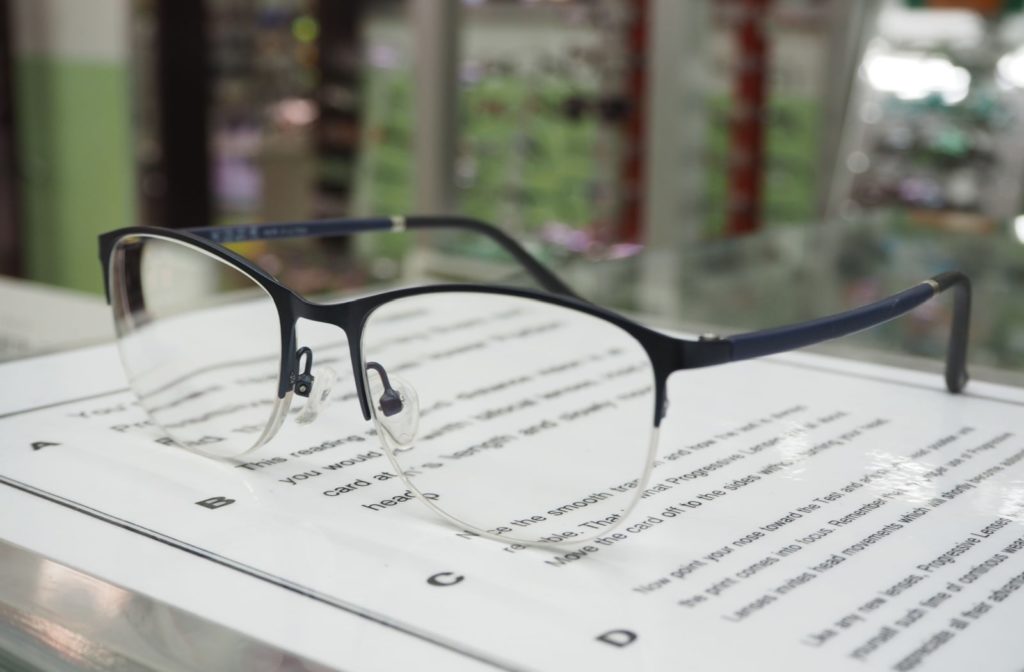Eyeglasses are a wonderful approach to treating common vision problems. However, some conditions can be a little trickier than others and may need a more nuanced touch. When conditions like presbyopia begin to develop, your optometrist may recommend progressive lenses. But what are progressive lenses?
Unlike regular eyeglasses, which utilize a single prescription, progressive lenses incorporate several prescriptions into one lens. Each viewing zone is ideal for different distances—such as distant, intermediate, and nearby.
The Basics of Progressive Lenses
When you wear a standard pair of eyeglasses, you’re usually using a single prescription. This is so you can have clear vision where your natural eye struggles to focus. This way, your glasses accommodate your refractive error at all distances, letting you see the world with clarity.
However, some eye conditions are a little more complicated, and a single prescription won’t do the trick. When this is the case, progressive lenses are often recommended. Rather than the lenses containing one prescription, they have several, each providing clear vision at a different distance.
Unlike bifocals or multifocals, which have a clear distinctive viewing line between prescriptions, progressive lenses offer a smooth transition between each viewing zone. As you get used to wearing them, you begin switching between the zones with ease. This provides you with clear vision at all distances.
How Do Progressive Lenses Work?
Progressive lenses are crafted to have a gradient between prescription powers. This means that the change is gradual from the top to the bottom of the lenses, and sometimes even to the sides. Each portion of the lens is tailored toward specific visual needs.
Rather than simply having one zone for distance and one zone for nearby vision, the lenses smoothly move from one zone to the next with no distinguishable line. They operate to correct visual problems that cause difficulty seeing at different distances that aren’t often treatable with single-prescription lenses.
By incorporating the three essential prescriptions for vision correction—distance, intermediate, and near—into one lens, you no longer have to switch between glasses for various activities. Often, the zones are designed with:
- An upper portion for distant vision
- A central portion for intermediate vision
- A lower portion for close-up activities
It’s an all-in-one approach to conditions that can be a little more complicated to treat with traditional methods.
What Are Progressive Lenses For?
To create a clear image, the eyes go through a complicated process in which light must pass through the pupil to the lens behind it. The lens will change shape to bend and focus light, resulting in clear vision.
When you’re younger, your eye lens is kind of like the lens on a camera. It changes shape as needed to be able to clearly focus at different distances. Switching from distant to nearby vision is simple. Your eye’s lens accommodates naturally and you likely don’t even notice.
But imagine a slow, steady change in your eye. This lens becomes less elastic over the years, making it more difficult to focus on nearby objects as well as it could when you were younger. This could interfere with several tasks, like:
- Reading
- Writing
- Watching television
- Driving
- Cooking
Any task that requires nearby vision may be a bit more difficult than it used to be. This is presbyopia—a refractive error that can develop later in life.
Unlike myopia, or nearsightedness, which can often be treated with a single prescription, presbyopia requires a more nuanced touch. You need a prescription for nearby, intermediate, and distant vision.
While you could get 3 pairs of glasses for each need, switching between them would be frustrating. That’s why progressive lenses exist—you can have all of your necessary prescriptions built into one single lens. It’s convenient, simple, and elegant.
Tips for Getting Used to Your Progressive Lenses
You’ve likely noticed something odd if you’ve worn glasses for most of your life. Whenever you change prescriptions, your eyes likely take a bit of time to adjust. While some people adjust within minutes, others may take days. This is completely normal.
However, with progressive lenses, this process may be a little more complicated. Your eyes aren’t exactly the same as when you were younger. They’ve gone through some changes over the years, and progressive lenses aren’t the same as a single prescription. You’re going to need to learn how to use each viewing zone properly until it becomes a natural motion.
Fortunately, there are some strategies you can use to get used to your progressive lenses.
Adapting Your Eyes to Progressive Lenses
The first step is learning how to use each zone. This is going to require some new eye movements that you may not be used to doing. While it may sound complicated, don’t worry—it’s easier than most people think.
You’ll need to get used to:
- Using the top zone when trying to focus on objects at a distance
- Using the middle zone to focus on objects in the intermediate range
- Using the bottom zone to read or do other activities up close
Being Consistent
This is an extremely important step. Even if you’re getting frustrated, try not to switch back to an old pair of glasses. You’ll need to be consistent when wearing your new progressive lenses—it’s just like practicing any other skill. You’ll get used to it!
However, if you need a break, don’t feel bad about it. Just take your time, take it slow, and give yourself some slack. Be consistent, and soon, all the movements will become second nature.
Keeping Your Glasses Clean
Many people are guilty of letting their lenses get a little dirtier than they should. However, a clean lens is going to be a lot easier to work with than a filthy one. Try to follow a cleaning routine like the one featured below:
- Start with a gentle lens cleaner. Don’t use harsh chemicals; they can damage the lenses.
- Use a soft, lint-free cloth, ideally microfiber, to apply the cleaner.
- Gently wipe the lenses, making sure to reach the entire surface.
- Rinse under lukewarm water.
- Dry the lenses with a clean microfiber cloth.
This way, your lenses will be able to properly refract light without grease, smudges, or dirt getting in the way.
Do You Need Prescription Lenses?
If you think you may need prescription lenses or have any other vision problems, come talk to our team at York Mills Eye Care. We can examine your eyes, provide you with a diagnosis, and help find a solution to treating your problem.
Don’t let vision problems interfere with your quality of life—book an appointment with our team today!





